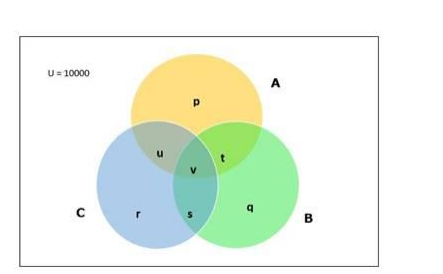In a town of 10,000 families, it was found that 40% of the families buy newspaper A, 20% buy newspaper B, 10% buy newspaper C, 5% buy A and B; 3% buy B and C, and 4% buy A and C. IF 2% buy all the three newspapers, find the number of families which buy
(i) A only,
(ii) B only,
(iii) none of $A, B$, and $C$.
Given:
Total number of families $=10000$
Percentage of families that buy newspaper $A=40$
Percentage of families that buy newspaper $B=20$
Percentage of families that buy newspaper $C=10$
Percentage of families that buy newspaper $A$ and $B=5$
Percentage of families that buy newspaper $B$ and $C=3$
Percentage of families that buy newspaper $A$ and $C=4$
Percentage of families that buy all three newspapers $=2$
To find:
(i) Number of families that buy newspaper A only
Consider the Venn Diagram below

Number of families that buy newspaper A = n(A) = 40% of 10000
= 4000
Number of families that buy newspaper B = n(B) = 20% of 10000 = 2000
Number of families that buy newspaper C = n(C) = 10% of 10000
= 1000
Number of families that buy newspaper $A$ and $B=n(A \cap B)$
$=5 \%$ of 10000
$=500$
Number of families that buy newspaper $B$ and $C=n(B \cap C)$
$=3 \%$ of 10000
$=300$
Number of families that buy newspaper $A$ and $C=n(A \cap C)$
$=4 \%$ of 10000
$=400$
Number of families that buys all three newspapers $=n(A \cap B \cap C)=v$
$=2 \%$ of 10000
$=200$
We have,
$n(A \cap B)=v+t$
$500=200+t$
$\mathrm{t}=500-200=300$
$\mathrm{n}(\mathrm{B} \cap \mathrm{C})=\mathrm{v}+\mathrm{s}$
$300=200+\mathrm{s}$
$\mathrm{s}=300-200=100$
$\mathrm{n}(\mathrm{A} \cap \mathrm{C})=\mathrm{v}+\mathrm{u}$
$400=200+\mathrm{u}$
$\mathrm{u}=400-200=200$
p = Number of families that buy newspaper A only
We have,
$A=p+t+v+u$
$4000=p+300+200+200$
$p=4000-700$
$p=3300$
Therefore,
Number of families that buy newspaper A only = 3300
(ii) Number of families that buy newspaper B only
q = Number of families that buy newspaper B only
$B=q+s+v+t$
$2000=q+100+200+300$
$q=2000-600=1400$
Therefore,umber of families that buy newspaper B only = 1400
(iii) Number of families that buys none of the newspaper
Number of families that buy none of the newspaper =
$10000-\{n(A)+n(B)+n(C)-n(A \cap B)-n(B \cap C)-n(A \cap C)+n(A \cap B \cap C)\}$
$=10000-(4000+2000+1000-500-300-400+200)$
$=10000-6000$
$=4000$
Therefore,
Number of families that buy none of the newspaper = 4000
Click here to get exam-ready with eSaral
For making your preparation journey smoother of JEE, NEET and Class 8 to 10, grab our app now.
